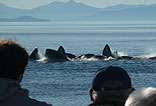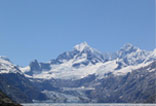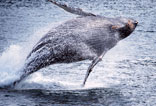 Frederick Sound Frederick Sound
Frederick Sound is a body of water approximately 45 miles wide in the central part of Southeast Alaska, at the confluence of Portage Bay (West), lower Stephens Passage (North), and Chatham Strait between the communities of Juneau (North) and Petersburg (South). Frederick Sound is only accessible by boat or air.
Abundant krill (small, shrimp-like crustaceans), zooplankton and herring thrive in the glacially fed waters of Frederick Sound, making it one of the premier places in Alaska to observe feeding humpback whales. It is estimated that over 500 of the 1,000 humpbacks that migrate annually to Alaska from Hawaiian breeding grounds head particularly to Frederick Sound to feed in its super nutrient-rich waters.
Marine mammals in the sound also include orcas (killer whales), Steller sea lions, Dall's porpoise, and harbor seals. A variety of seabirds thrive in this region as well and can be observed flying overhead or flocking after the whale's watery leftovers, creating a great clue to where the humpbacks might be. Surrounding the sound are the majestic craggy snow-covered mountains of the Coast Range rising from the sea to grand heights of 10,000 feet.
 Glacier Bay National Park & Preserve Glacier Bay National Park & Preserve
Glacier Bay Park and Preserve is reportedly the most sought after park to visit in the United States and it is no wonder. Where else will you find a 25 mile-long river of ice still carving the land just as it has for the past several thousand years? When Captain Cook and George Vancouver sailed by in 1879, they saw a 20-mile wide glacier where today the entrance of the park lies, as well the wilderness lodge and park headquarters.
Over the past 200 years, this wall of ice has retreated an astonishing 65 miles north, splintering into a vast number of tributaries spaced throughout the entire park. Each glacier has its own name and character; our captain will decide which to visit for the day depending on ice conditions and wildlife sightings.
Visiting Glacier Bay Park is also like visiting a wildlife park. Here bears, goats, moose, whales, sea otters, and all the creatures of the water and forest flourish, completely protected from man. A National Park Ranger joins us for our entire journey to explain the park's geology, glaciology, wildlife, and its deep roots in Tlingit culture.
 Icy Strait Icy Strait
Icy Strait is a body of water in Southeast Alaska that is located between Chichagof Island and the mainland, and extends 40 miles northwest from Chatham Strait to Glacier Bay and Cross Sound. Icy Strait's nutrient-rich waters are abundant with marine mammals, sea birds and the scenery is spectacular.
 Juneau, Alaska Juneau, Alaska
Surrounded by the rich, green Tongass National Forest, and located on beautiful Gastineau Channel, Juneau is an important port and a popular tourist destination. Unique because it is one of only two state capitals in the United States that is inaccessible by road, Juneau sits at sea level below the steep mountains that are home to the Juneau Icefield and the Mendenhall Glacier. Its temperate climate produces remarkable scenery with miles of hiking trails through woods and alpine meadows providing a glimpse of just how rugged the rainforest of Southeast Alaska is.
The Auke tribe of Tlingit Indians were the first settlers in the Juneau area. They lived there peacefully enjoying the abundance of food and natural resources until the gold rush began. First named Rockwell and then Harrisburg, Juneau was finally named after gold prospector Joseph Juneau. In 1880, he and his partner, Richard Harris, discovered gold nearby, and the city quickly developed into a gold rush town.
During the lucrative 60 years of gold mining in the area Juneau was home to three of the world's largest gold mines: The Alaska Juneau mine, the Alaska Gastineau mine, and the Treadwell mine. These three mines produced $158 million worth of gold making Juneau one of the world's major gold mining areas until the 1940s when costs outstripped the value of the gold. However, since 2005 the gold mining industry has been experiencing a resurgence.
Officially designated the capital of the Territory of Alaska in 1900, it did not function as the capital until the government offices were moved there from Sitka in 1906. In 1959 Juneau became the official state capital when Alaska was admitted to the United States. Today, its approximately 31,000 citizens live within a 3,255 square mile boundary, an amount of land that makes Juneau's city limits the largest state capital in the United States (and the only state capital that borders a foreign city.)
Along with its delightful small town ambiance, Juneau has a number of art galleries, boutiques, historical sites, and museums. In town you can visit the Alaska State Museum, the House of Wickersham, the Patsy Ann Statue, the 5-stories-tall totem pole outside the Capital Building, the Juneau-Douglas City Museum, the Alaska-Juneau gold mine or the salmon hatchery.
One of the most popular attractions in the area is Mendenhall Glacier, located only 13 miles outside the city. Although it's receding, it is an amazing work of nature. Other attractions include the Mendenhall Wetlands State Game Refuge (providing a look at Alaska's salt marshes and the migratory waterfowl protected there); the Juneau Icefield; the Mt. Roberts Tram (rises 1,800 feet and presents sweeping views of downtown Juneau and Gastineau Channel.) There are more than 205 trails within and surrounding Juneau. They range from fairly flat hikes accessible to wheelchairs and stroller to medium hikes up and down forest trails to strenuous uphill paths for serious hikers.
|

